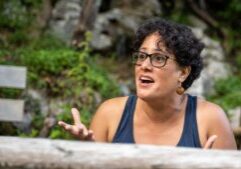Hello everyone! Imagine my surprise with Susan Koefod mentioned that she’d like to do a guest post for Red Sofa Literary. I’ve known Susan for a few years now, and she is the penultimate professional and a joy to know! Plus Susan wanted to share her experience of working with an agent (which happened to be me) and how it impacted her writerly life. So enjoy, and thanks again Susan 🙂
__________________________________________
By Susan Koefod
In August 2008, my writing partners and I were THRILLED to receive an email from Dawn Frederick of Red Sofa Literary in response to our query for our non-fiction anthology project Let Them Eat Crepes: Stories Featuring the French Pancake. She thought our project idea fun and appealing to her taste, and was eager to work with us.
Little did we know that even after months of work in crafting our non-fiction anthology; including requesting, selecting and editing twenty essays – extensive research, and writing of a book proposal –this was only the beginning of the process.
It would take another six months to fine-tune the proposal, which ended up being 70-pages long with numerous attachments, including sample chapters. There’s no need to go into all the details of how to write a book proposal here, but I wanted to share what I learned about the agent/author process. As I’ve constantly told Dawn every time we see each other, I’ve applied all the knowledge gained by this experience into my other publishing successes.
RESEARCH, AND THEN RESEARCH MORE
There are two areas that need to be addressed. The first is research, a necessity for a non-fiction book proposal, but there are applications to a work of creative prose (addressed below). With our research it was necessary to prove to Dawn, and ultimately publishers, why our book idea was unique, why we were the only authors for the project. Who was our audience? Why would readers buy our book? Even though our initial plan was detailed, Dawn had us strengthen our argument.
MARKETING PLAN
The second important area of any book proposal is the Marketing Plan. Did our marketing plan prove we were 150% dedicated not just to our brilliant idea? Did it reflect our commitment to a rock solid plan of how we would build awareness of our book and our ‘brand’ as authors? How would we identify and reach out to our audience? How was our audience going to find us? Would our book get noticed enough to convince a major publisher to place resources in a group of three unknown Midwestern writers?
No matter how detailed our plan was, Dawn had numerous ideas about how to make it even more focused and detailed. What about co-marketing with a local cooking store? Or large national retailers such as Williams-Sonoma? How would we reach people who loved food, but weren’t interested in cooking?
PATIENCE
The biggest lesson, above all the minutiae of the proposal, was learning how to manage our own expectations. At the time, we were all unpublished writers, with a few literary journal credits among us. We’d worked long and hard on our proposal and query letters, then worked even harder to get the proposal shaped up for Dawn to do her job.
We controlled the overall book idea. When that was finished, we thought the rest would be easy and smooth. But the hard lesson was, it wasn’t, since we couldn’t control the whims and time schedules and interests of editors at major publishing houses.
Additionally we couldn’t control the economy, both the broad one and its effects on the publishing industry. During that time Dawn was bringing our book to editors, the recession was just starting. Publishers were undergoing major staff and budget cuts – and the industry is still in a state of transition.
Even taking into account all of these factors, it was still hard to avoid the temptation of pestering Dawn and ask how things were going. Rest assured, we learned that she keeps track of who receives a proposal, any follow-up, any response. And if she has good news, she shares it immediately. The fact of the matter was that no matter how much she believed in us and worked with us on our book proposal, it wasn’t finding a home.
In June of 2010, after over a year of pitching our book to 46 editors, we all agreed to shelve the project. Some editors never answered, some flat out said no with no explanation, or the gentle “not for us”, and generally others doubted the idea for this single-food category to break out on shelves (even though we pitched crepes as the new cupcake!)
A few months later, two of us decided that the only way to bring closure to the project, and the years of work we put into it, was to self-publish the book through Lulu publishing. When we were ready to launch our book, guess what we did? We followed the extremely detailed marketing plan we’d slaved over with Dawn, including holding an event at the wonderful Common Good Books, one of the Twin Cities premiere independent bookstores. Our event was a publishing high point for the project editors.
We met our modest self-publishing goals: putting out a beautiful book we could be proud of and breaking even. Our book has sold well and continues to receive (very modest) royalties from Lulu!
Since then I’ve published a series of mystery novels with North Star Press. My query to North Star was built from the lesson of working with Dawn (why was North Star the right place for my book and how was I prepared to sell my book). My book launch plan had, at its root, various aspects of the Let Them Eat Crepes marketing plan (building a platform, plan for media, plan for retail outreach). I snagged a review that appeared in the local press (St. Paul Pioneer Press) and had was even more thrilled when Library Journal called my first book “a smashing debut with astute observations and gorgeous prose.”
I didn’t rest with just getting that review. I made sure the media, bookstores, and everyone on my contact list knew about it, as it was the perfect way to help sell my wonderful book.
Until I worked with Dawn, I never understood the business side of any brilliant creative idea is even harder work. It’s one thing to type away in the comforts of your writing garret. It’s quite another to gather an audience of fans willing to put money on the table for those words.
BIO
Susan Koefod’s mystery series debuted with Washed Up, which was praised by Library Journal (September 2011) as “a smashing debut with astute observations and gorgeous prose” and listed as a top 200 pick on Library Journal’s debut novel list in October 2011. The book was a 2011 Midwest Book Award finalist. Her second book, Broken Down (September 2012), was been called a “fast, fresh and smart follow-up… in what promises to be a first-rate series” by Edgar Award-winning author David Housewright. The third book in the series, Burnt Out, is set for release this fall. With Melissa Doffing, she self-published Let Them Eat Crepes: Stories Featuring the French Pancake (September 2010). She lives in Minnesota with her family.








[…] out by reading my guest blog at Red Sofa […]